Come along with us as we journey through the Great Smoky Mountains! We will virtually hike over the ten highest peaks, immersing ourselves in their majestic beauty. We’ll traverse rugged trails with each step, surrounded by lush forests and cascading waterfalls. As we explore these trails, we will experience the grandeur of the Great Smoky Mountains and marvel at the wonders of nature. All without leaving the climate-controlled comfort of home! So, lace up your virtual hiking boots, as we discover the 10 highest peaks in the Smoky Mountains!
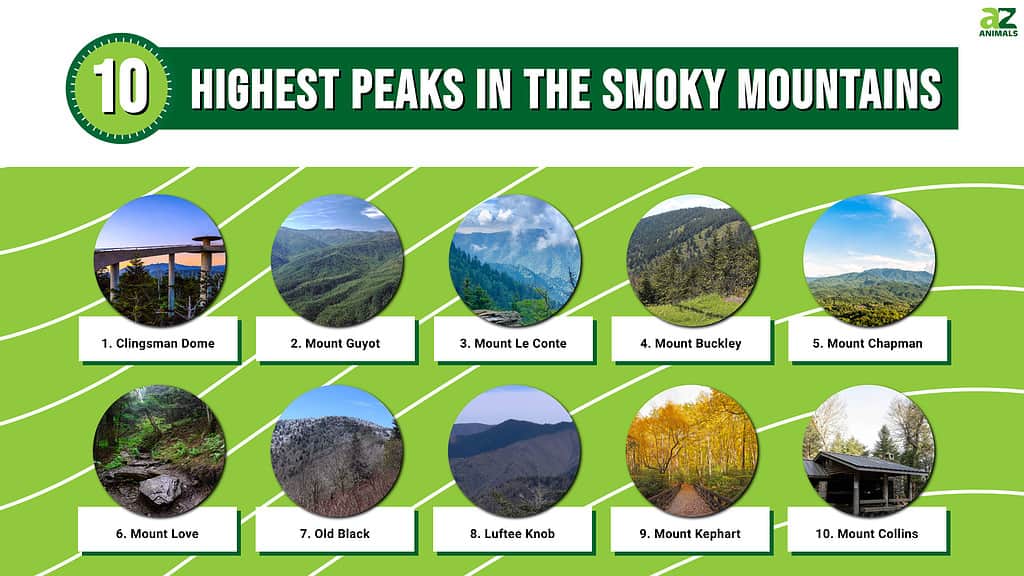
The Great Smoky Mountains
The Great Smoky Mountains, often referred to as the Smokies, are a range of mountains located on the border between Tennessee and North Carolina in the Southeastern United States. They are part of the larger Appalachian Mountain chain and are renowned for their stunning beauty, rich biodiversity, and cultural significance. Geographically, the Smokies are characterized by their prominent peaks, lush valleys, cascading waterfalls, and dense forests.
The lower elevations of the region experience a humid subtropical climate, resulting in warm, humid summers and mild to cold winters, making it an ideal destination for outdoor enthusiasts throughout the year.
A defining feature of the Smoky Mountains is the smoky haze that often blankets the valleys that give the range its name. The mist is caused by the abundant vegetation releasing volatile organic compounds, which, when combined with moisture and sunlight, create a beautiful, ethereal atmosphere. In addition, the haze adds to the overall charm and mystique of the region.
Great Smoky Mountains National Park
The Great Smoky Mountains National Park, established in 1934, is the crown jewel of the region. It covers over 520,000 acres (210,000 hectares) and is also recognized as one of the most biodiverse areas in North America. The park is home to an incredible array of fauna and flora. This diversity is attributed to the range of elevations found within the park.
Hiking is popular in the Smokies, with over 800 miles (1,300 km) of trails winding through the mountains. In addition, these trails cater to all skill levels. Find easy strolls to challenging multi-day hikes. Visitors can explore the breathtaking landscapes, discover hidden waterfalls, and also witness the vibrant fall foliage that attracts millions of visitors each year.
Conservation and preservation efforts have played a crucial role in maintaining the integrity of the Smoky Mountains. The national park is recognized as a UNESCO World Heritage Site and an International Biosphere Reserve. These designations ensure the protection of its ecosystems, wildlife, and also cultural heritage for future generations to enjoy.

The Great Smoky Mountains are located on the border between Tennessee and North Carolina.
©iStock.com/Aneese
Appalachian Trail
The Appalachian Trail, often referred to as the A.T., is a long-distance hiking trail that spans approximately 2,190 miles (3,524 kilometers) from Springer Mountain, Georgia to Mount Katahdin, Maine. Within the Smokies, the Appalachian Trail covers a distance of approximately 71 miles (114 kilometers) as it winds through the rugged terrain and scenic overlooks. In addition, hiking the Appalachian Trail through the Great Smoky Mountains offers the opportunity to immerse oneself in the natural beauty and rich biodiversity of the region.

Hiking the Appalachian Trail through the Great Smoky Mountains offers the opportunity to immerse oneself in the natural beauty and rich biodiversity of the region.
©iStock.com/ehrlif
1. Clingsman Dome
Clingmans Dome is the highest peak in the Great Smoky Mountains. It stands at an impressive elevation of 6,643 feet (2,025 m) above sea level. It is approximately 13 miles (21 km) southeast of Gatlinburg, Tennessee, and 54 miles (87 km) west of Asheville, North Carolina.
At the summit of Clingmans Dome, there is an iconic observation tower that provides stunning panoramic views of the surrounding mountains and valleys. The tower, constructed in 1959 of concrete and steel, stands 45 feet (14 m) tall and is accessible via a paved trail. To reach the observation tower, however, visitors can hike the Clingmans Dome Trail, a steep half-mile (0.8 km) paved trail that ascends to the summit. The trail is relatively short but strenuous due to its steep grade. The elevation gain is approximately 330 feet (100 m).

From the observation tower at Clingmans Dome, visitors can enjoy breathtaking vistas that stretch for miles.
©iStock.com/SeanPavonePhoto
Clingsman Dome Climate
Clingmans Dome has a sub-alpine climate due to its high elevation. The temperatures are generally cooler than the surrounding lower elevations. The area also receives higher amounts of precipitation, contributing to the lush vegetation and abundant plant life.
The high elevation of Clingmans Dome supports a variety of plant and animal species. The spruce-fir forest found at the summit provides a habitat for several rare species. These include the spruce-fir moss spider and the Carolina Northern flying squirrel. At the trailhead of Clingmans Dome, there is a parking area, restrooms, and a visitor information center. In addition, the information center offers exhibits on the natural and cultural history of the area, providing visitors with insights into the significance of Clingmans Dome.

The high elevation of Clingmans Dome supports a variety of plant and animal species.
©iStock.com/Sam Fowler
2. Mount Guyot
One of the highest peaks in the Smoky Mountains is Mount Guyot. With its impressive elevation and position along the Appalachian Trail, Mount Guyot offers nature enthusiasts a chance to explore the rugged beauty of the Great Smoky Mountains.
Mount Guyot is the second-highest peak in the Great Smoky Mountains. The peak is named after Arnold Henry Guyot, a Swiss-American geographer and geologist. In addition, the Appalachian Trail passes within 1,000 feet (300 m) of the Mount Guyot summit making it a notable milestone for hikers on their journey.
However, Mount Guyot is actually composed of two distinct summits, referred to as North Guyot and South Guyot. North Guyot is slightly higher, standing at an elevation of 6,621 feet (2,018 m). South Guyot reaches an elevation of 6,578 feet (2,005 m). The peaks are located very close to each other, and both also offer stunning views of the surrounding landscape.
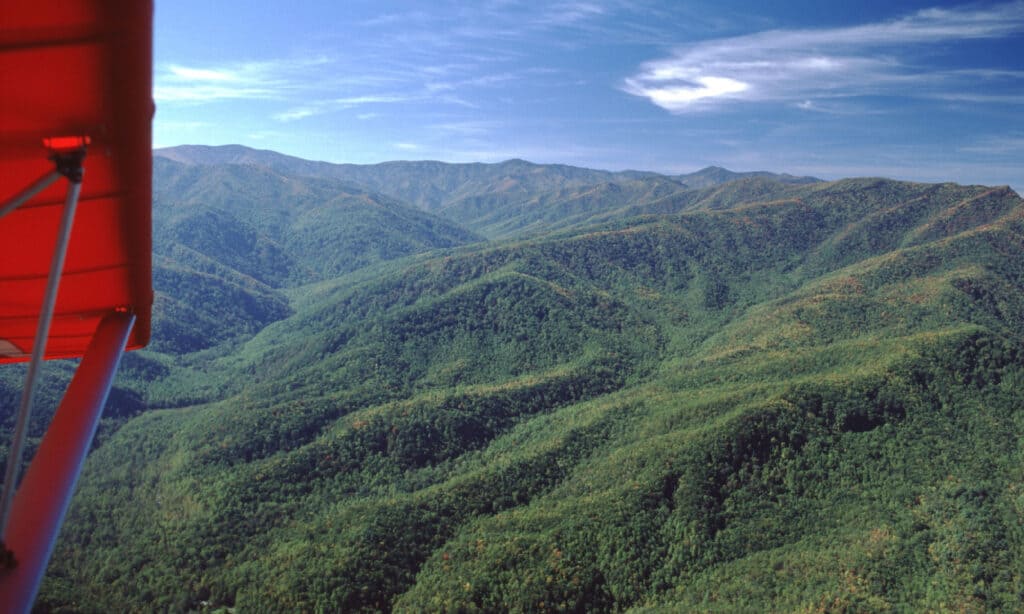
Mount Guyot is the second-highest peak in the Great Smoky Mountains.
©iStock.com/Weber
3. Mount Le Conte
Mount Le Conte is one of the most iconic and beloved highest peaks in the Great Smoky Mountains. Known for its stunning vistas, diverse ecosystems, and rich history, Mount Le Conte holds a special place in the hearts of visitors and locals alike.
Mount Le Conte reaches an elevation of 6,593 feet (2,010 m) above sea level, making it the third-highest peak in the Great Smoky Mountains. Mount Le Conte stands out due to its distinctive profile and rocky outcroppings. Its rugged slopes and prominent cliffs contribute to its striking appearance and also provide unique viewpoints for visitors.
Le Conte: Sub-peaks
Mount Le Conte actually consists of multiple peaks. The four main sub-peaks, from east to west, are known as Myrtle Point, Cliff Tops, High Top, and West Point. However, Cliff Tops is the highest of these summits, offering panoramic views of the surrounding mountains. Mount Le Conte is accessible via several hiking trails.
The most popular routes include the Alum Cave Trail, Rainbow Falls Trail, Trillium Gap Trail, and also Boulevard Trail. These trails vary in length, difficulty, and scenery, providing options for hikers of different skill levels. At the top of Mount Le Conte, nestled among the lush forests, is Le Conte Lodge. The lodge offers rustic cabins with limited amenities and also serves home-cooked meals. However, reservations for accommodations at Le Conte Lodge need to be made well in advance, as it is a highly sought-after destination.
Mount Le Conte supports a variety of forest types, including spruce-fir forests at higher elevations and hardwood forests in the lower areas. Visitors can encounter a wide range of plant and animal life, including rare and endemic plants like the Fraser fir and various fern species.
The area has been used by indigenous peoples for thousands of years, and remnants of their presence, such as artifacts and rock shelters, can still be found. The mountain is named after Joseph Le Conte, a renowned geologist, and also early conservationist who played a significant role in the establishment of the national park. Mount Le Conte is sure to leave a lasting impression on all who visit the Great Smoky Mountains.
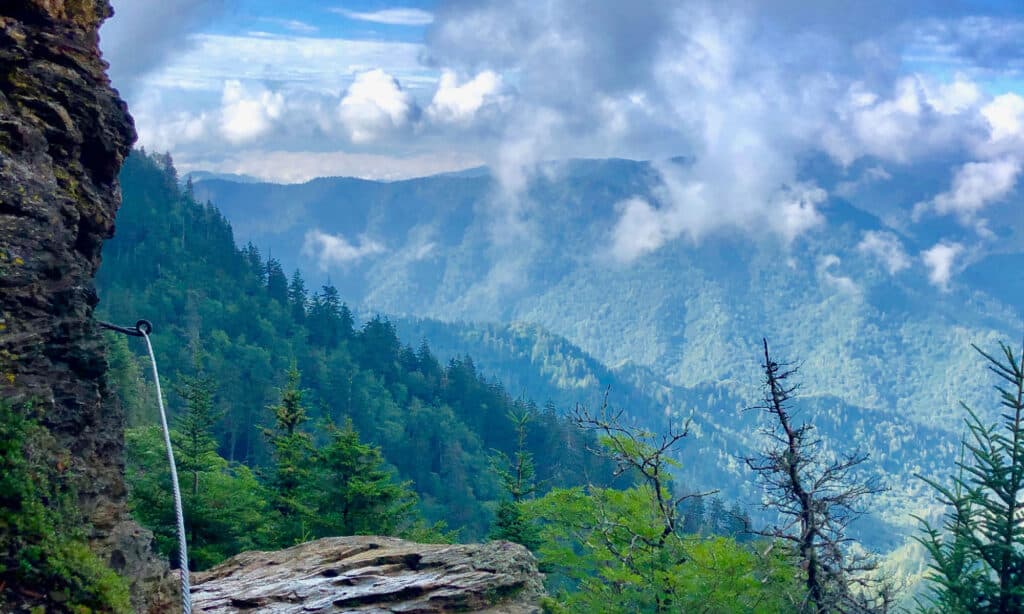
Mount Le Conte is one of the most iconic and beloved peaks in the Great Smoky Mountains.
©Sara Parlier/Shutterstock.com
4. Mount Buckley
While Mount Buckley may not be as widely recognized as some other peaks in the Great Smoky Mountains, it is the fourth-highest peak in the range. Mount Buckley has an elevation of 6,580 feet (2,005 m) above sea level. Mount Buckley is named for Samuel Botsford Buckley, an American botanist, geologist, and naturalist. Like many peaks in the Great Smoky Mountains, Mount Buckley offers scenic beauty and the chance to enjoy panoramic views of the surrounding landscape.
From its summit or nearby viewpoints, visitors can take in the sweeping vistas of the rolling peaks, dense forests, and valleys that make the region so captivating. Mount Buckley can be accessed via The Dome Bypass Trail or the Clingmans Dome Trail. The mountain supports various types of vegetation, including hardwood forests and also spruce-fir forests at higher elevations. Wildlife such as black bears, white-tailed deer, and various bird species can be found in the area.
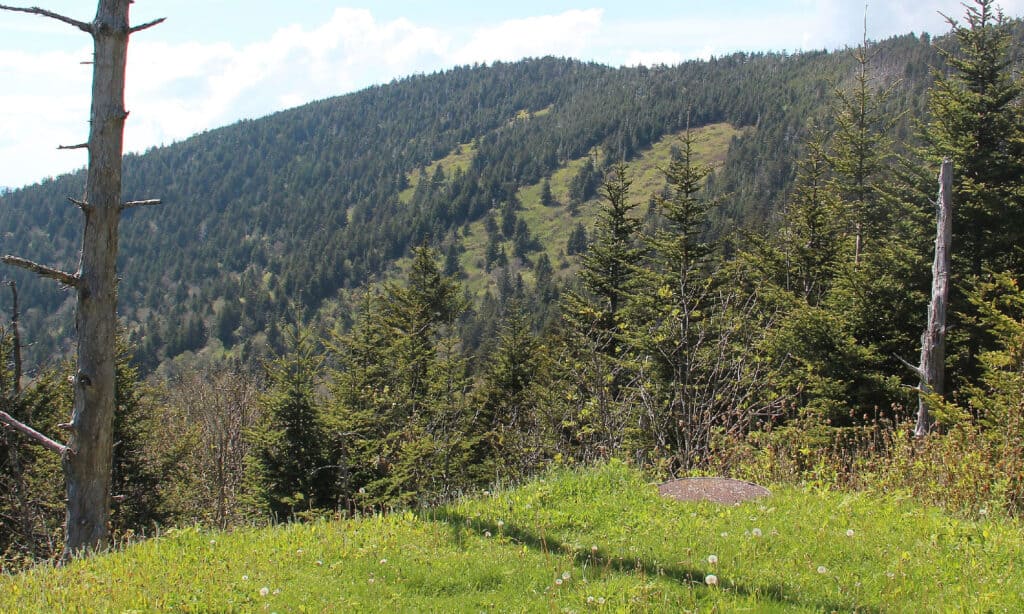
While Mount Buckley may not be as widely recognized as some other peaks in the Great Smoky Mountains, it is the fourth-highest peak in the range.
©Thomson200 / Creative Commons – License
5. Mount Chapman
Mount Chapman has an elevation of approximately 6,417 feet (1,956 meters) above sea level. While it is not one of the highest peaks in the Great Smoky Mountains, it still offers impressive views and a notable presence within the range. It is situated near the Appalachian Trail and is part of the expansive wilderness area of the national park.
Mount Chapman is accessible via hiking trails in the Great Smoky Mountains National Park. The most likely approach to Mount Chapman is by hiking along the Appalachian Trail or other connecting trails in the vicinity. As with any backcountry hiking, it’s important to be adequately prepared, follow safety guidelines, and possess navigation skills.
In addition, the peak is named for David C. Chapman, a Knoxville, Tennessee businessman, who as head of the Tennessee Great Smoky Mountains Park Commission raised funds and purchased the land that would become the park.

While Mount Chapman is not one of the highest peaks in the Great Smoky Mountains, it still offers impressive views and a notable presence within the range.
©Mihai_Andritoiu/Shutterstock.com
6. Mount Love
Mount Love, the next highest peak in the Great Smoky Mountains. It is located in North Carolina. Mount Love is not as popular as some other peaks due to its summit being heavily forested. This feature precludes the possibility of breathtaking views and scenic overlooks. In addition, Mount Love, 6400 feet (1951 m), is located on the same ridge as Clingmans Done. The peak has its share of visitors, however, as the peak is on the Appalachian Trail, between Clingmans Dome and Mount Collins.

Visitors to Mount Love must take the Clingman’s Dome Trail to Clingman’s Dome – then follow the Appalachian Trail northeast to Mount Love.
Image: Donna Bollenbach, Shutterstock
©Donna Bollenbach/Shutterstock.com
7. Old Black
Old Black has an elevation of approximately 6,370 feet (1,941 m) above sea level. While it may not be one of the highest peaks in the Great Smoky Mountains, it is still a prominent feature within the range. Old Black is situated in the Eastern part of the Great Smoky Mountains National Park, on the border between Tennessee and North Carolina. It is part of the rugged and also scenic wilderness area of the park.
Old Black is accessible via hiking trails in the Great Smoky Mountains National Park. However, the summit of Old Black is heavily forested, offering very little in the way of panoramic views.
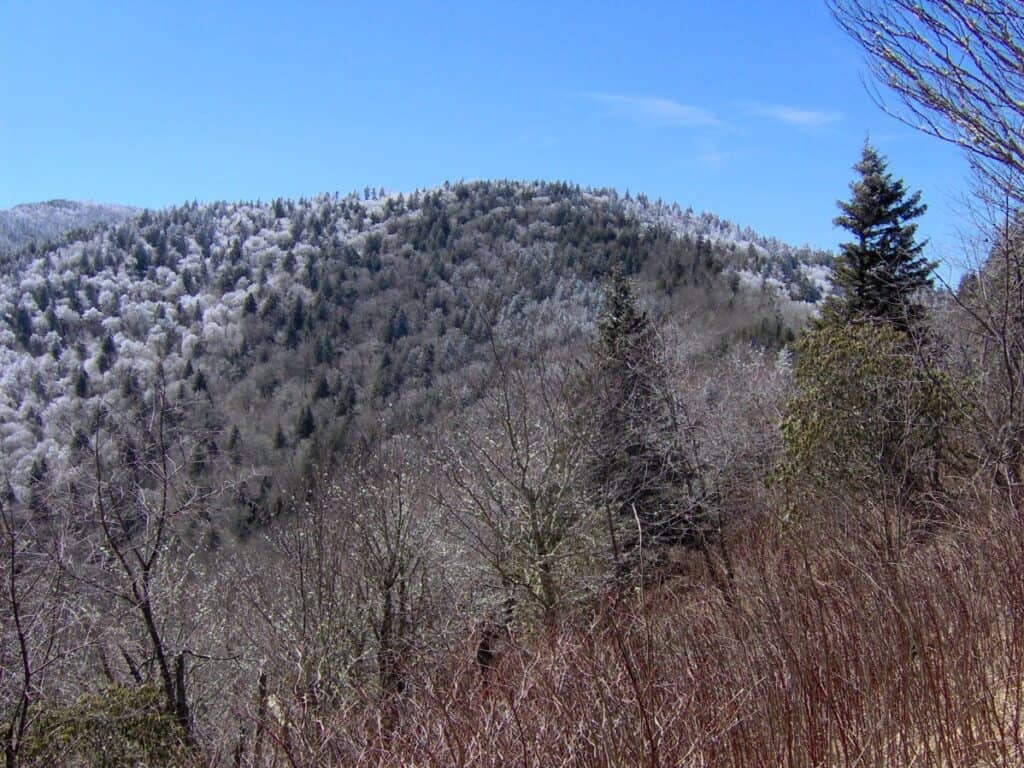
Old Black has an elevation of approximately 6,370 feet (1,941 m) above sea level.
©Brian Stansberry / Creative Commons – License
8. Luftee Knob
Luftee Knob has an elevation of approximately 5,620 feet (1,713 meters) above sea level. It offers breathtaking panoramic views of the surrounding mountains and valleys. From the summit, visitors can enjoy sweeping vistas of the Great Smoky Mountains, including the rolling peaks, deep valleys, and also dense forests that characterize the region.
Luftee Knob supports diverse ecosystems and a rich variety of plant and animal life. In addition, Luftee Knob lies within the ancestral lands of the Cherokee people and has cultural and historical significance. The area has a rich heritage and has been inhabited by indigenous peoples for thousands of years.
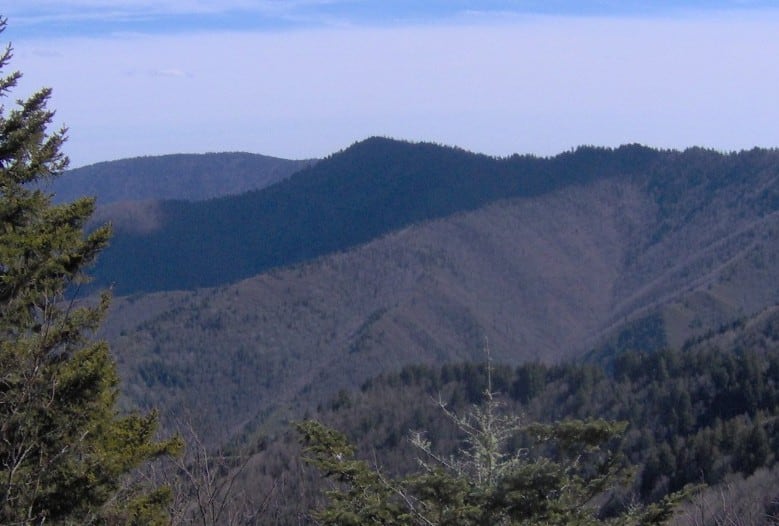
Luftee Knob has an elevation of approximately 5,620 feet (1,713 meters) above sea level.
©Brian Stansberry, CC BY 3.0 – License
9. Mount Kephart
Mount Kephart has an elevation of 6,217 feet (1,895 m) above sea level. It is named in honor of Horace Kephart, an American author, and outdoorsman who played a significant role in the preservation and promotion of the Great Smoky Mountains. Kephart’s writings and advocacy contributed to the establishment of the national park and the preservation of the region’s natural beauty.
Mount Kephart is notable for its association with the Appalachian Trail. The trail traverses the south slope of Mount Kephart. Kephart Prong is a scenic stream originating near the mountain, which can be accessed by the Kephart Prong Trail. The Jump-Off Trail offers spectacular panoramic views of the surrounding mountains and valleys. It provides a breathtaking vantage point to take in the vastness and natural splendor of the Great Smoky Mountains.
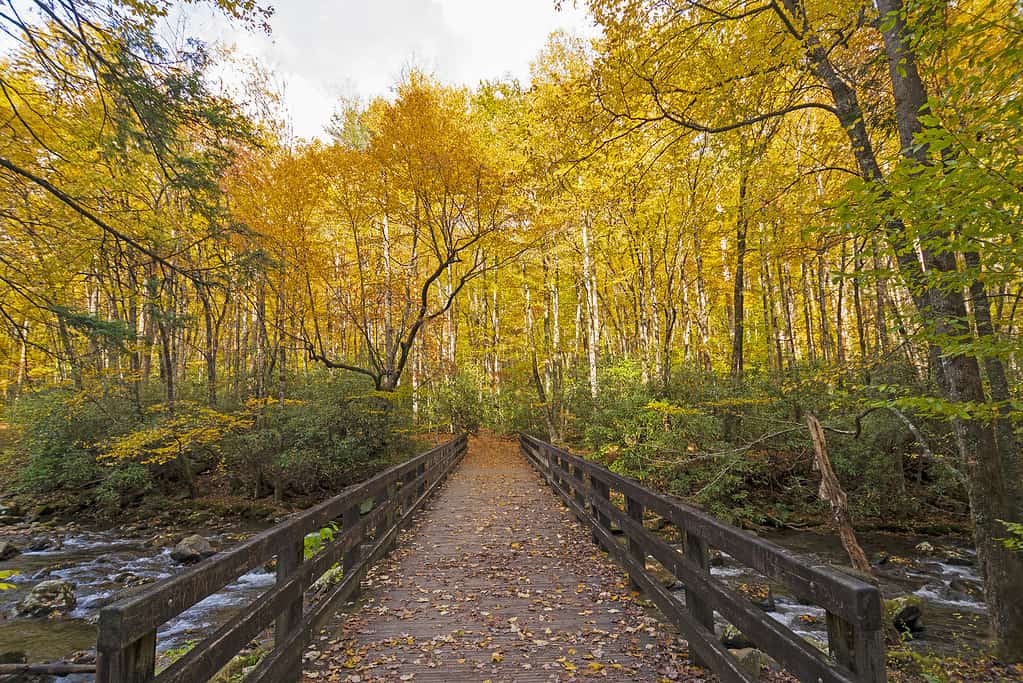
Bridge on the Kephart Prong Trail in Great Smoky Mountains National Park.
©iStock.com/Wildnerdpix
10. Mount Collins
Mount Collins has an elevation of approximately 6,188 feet (1,886 meters) above sea level. It is situated along the Appalachian Trail, one of the most famous long-distance hiking trails in the United States. The trail passes near the summit of Mount Collins, making it accessible to hikers and backpackers who traverse this iconic trail.
Mount Collins offers beautiful vistas and scenic views of the surrounding mountains and valleys. From its summit or nearby viewpoints, visitors can take in the sweeping panoramas of the Great Smoky Mountains, with its rolling peaks and lush forests.
Mount Collins, like the rest of the Great Smoky Mountains, is home to diverse ecosystems and a wide range of plant and animal species. The mountain supports various types of vegetation, including hardwood forests and spruce-fir forests at higher elevations. Wildlife such as black bears, white-tailed deer, and a variety of bird species can be found in the area.
Mount Collins: Legacy
Mount Collins is named in honor of Martha “Mattie” E. Collins, a teacher and conservationist who played a significant role in the establishment of the Great Smoky Mountains National Park. She was known for her efforts in preserving the natural beauty of the area and advocating for its protection. Mount Collins, then, serves as a reminder of the important conservation efforts that led to the establishment of the Great Smoky Mountains National Park. The park, renowned for its natural beauty and rich biodiversity, stands as a testament to the vision and dedication of individuals like Martha Collins.

Mount Collins Shelter, along the Appalachian Trail.
©Kelly vanDellen/Shutterstock.com
Summary of The 10 Highest Peaks in the Smoky Mountains
| Name | Height | |
|---|---|---|
| 1 | Clingmans Dome | 6643 feet; 2025 meters |
| 2 | Mount Guyot | 6621 feet; 2018 meters |
| 3 | Mount Le Conte | 6593 feet; 2010 meters |
| 4 | Mount Buckley | 6560 feet; 1999 meters |
| 5 | Mount Chapman | 6417 feet; 1956 meters |
| 6 | Mount Love | 6400 feet; 1951 meters |
| 7 | Old Black | 6370 feet; 1942 meters |
| 8 | Luftee Knob | 6234 feet; 1900 meters |
| 9 | Mount Kephart | 6217 feet; 1895 meters |
| 10 | Mount Collins | 6188 feet; 1886 meters |
The photo featured at the top of this post is © iStock.com/SeanPavonePhoto
Thank you for reading! Have some feedback for us? Contact the AZ Animals editorial team.






